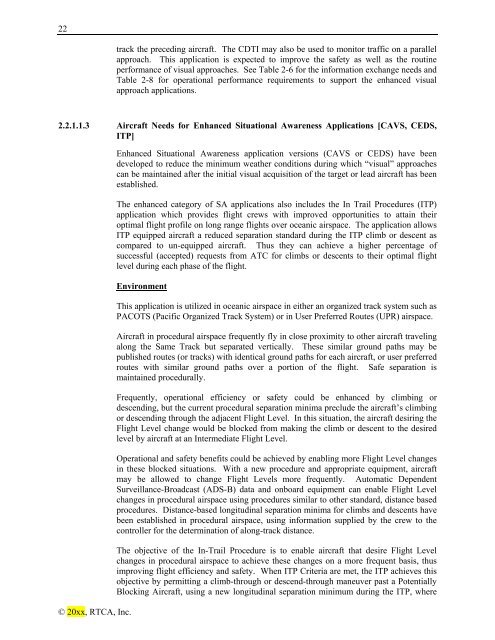Minimum Aviation System Performance Standards for Aircraft ...
Minimum Aviation System Performance Standards for Aircraft ...
Minimum Aviation System Performance Standards for Aircraft ...
You also want an ePaper? Increase the reach of your titles
YUMPU automatically turns print PDFs into web optimized ePapers that Google loves.
22<br />
track the preceding aircraft. The CDTI may also be used to monitor traffic on a parallel<br />
approach. This application is expected to improve the safety as well as the routine<br />
per<strong>for</strong>mance of visual approaches. See Table 2-6 <strong>for</strong> the in<strong>for</strong>mation exchange needs and<br />
Table 2-8 <strong>for</strong> operational per<strong>for</strong>mance requirements to support the enhanced visual<br />
approach applications.<br />
2.2.1.1.3 <strong>Aircraft</strong> Needs <strong>for</strong> Enhanced Situational Awareness Applications [CAVS, CEDS,<br />
ITP]<br />
© 20xx, RTCA, Inc.<br />
Enhanced Situational Awareness application versions (CAVS or CEDS) have been<br />
developed to reduce the minimum weather conditions during which “visual” approaches<br />
can be maintained after the initial visual acquisition of the target or lead aircraft has been<br />
established.<br />
The enhanced category of SA applications also includes the In Trail Procedures (ITP)<br />
application which provides flight crews with improved opportunities to attain their<br />
optimal flight profile on long range flights over oceanic airspace. The application allows<br />
ITP equipped aircraft a reduced separation standard during the ITP climb or descent as<br />
compared to un-equipped aircraft. Thus they can achieve a higher percentage of<br />
successful (accepted) requests from ATC <strong>for</strong> climbs or descents to their optimal flight<br />
level during each phase of the flight.<br />
Environment<br />
This application is utilized in oceanic airspace in either an organized track system such as<br />
PACOTS (Pacific Organized Track <strong>System</strong>) or in User Preferred Routes (UPR) airspace.<br />
<strong>Aircraft</strong> in procedural airspace frequently fly in close proximity to other aircraft traveling<br />
along the Same Track but separated vertically. These similar ground paths may be<br />
published routes (or tracks) with identical ground paths <strong>for</strong> each aircraft, or user preferred<br />
routes with similar ground paths over a portion of the flight. Safe separation is<br />
maintained procedurally.<br />
Frequently, operational efficiency or safety could be enhanced by climbing or<br />
descending, but the current procedural separation minima preclude the aircraft’s climbing<br />
or descending through the adjacent Flight Level. In this situation, the aircraft desiring the<br />
Flight Level change would be blocked from making the climb or descent to the desired<br />
level by aircraft at an Intermediate Flight Level.<br />
Operational and safety benefits could be achieved by enabling more Flight Level changes<br />
in these blocked situations. With a new procedure and appropriate equipment, aircraft<br />
may be allowed to change Flight Levels more frequently. Automatic Dependent<br />
Surveillance-Broadcast (ADS-B) data and onboard equipment can enable Flight Level<br />
changes in procedural airspace using procedures similar to other standard, distance based<br />
procedures. Distance-based longitudinal separation minima <strong>for</strong> climbs and descents have<br />
been established in procedural airspace, using in<strong>for</strong>mation supplied by the crew to the<br />
controller <strong>for</strong> the determination of along-track distance.<br />
The objective of the In-Trail Procedure is to enable aircraft that desire Flight Level<br />
changes in procedural airspace to achieve these changes on a more frequent basis, thus<br />
improving flight efficiency and safety. When ITP Criteria are met, the ITP achieves this<br />
objective by permitting a climb-through or descend-through maneuver past a Potentially<br />
Blocking <strong>Aircraft</strong>, using a new longitudinal separation minimum during the ITP, where

















